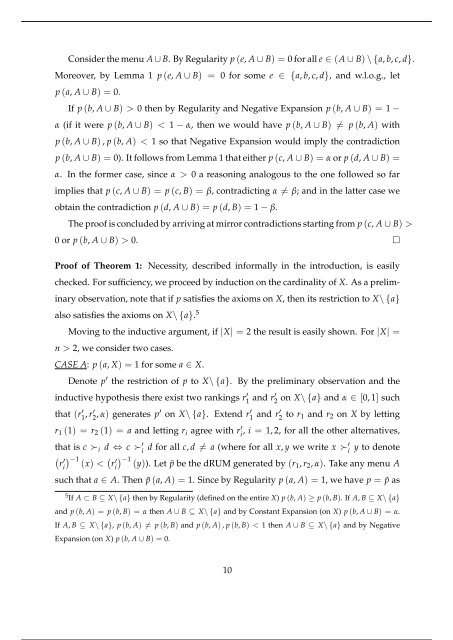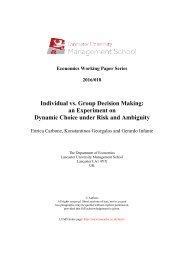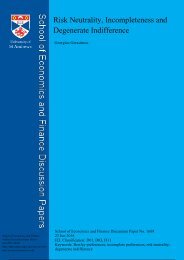Dual Random Utility Maximisation
n?u=RePEc:san:wpecon:1605&r=upt
n?u=RePEc:san:wpecon:1605&r=upt
You also want an ePaper? Increase the reach of your titles
YUMPU automatically turns print PDFs into web optimized ePapers that Google loves.
Consider the menu A ∪ B. By Regularity p (e, A ∪ B) = 0 for all e ∈ (A ∪ B) \ {a, b, c, d}.<br />
Moreover, by Lemma 1 p (e, A ∪ B) = 0 for some e ∈ {a, b, c, d}, and w.l.o.g., let<br />
p (a, A ∪ B) = 0.<br />
If p (b, A ∪ B) > 0 then by Regularity and Negative Expansion p (b, A ∪ B) = 1 −<br />
α (if it were p (b, A ∪ B) < 1 − α, then we would have p (b, A ∪ B) ̸= p (b, A) with<br />
p (b, A ∪ B) , p (b, A) < 1 so that Negative Expansion would imply the contradiction<br />
p (b, A ∪ B) = 0). It follows from Lemma 1 that either p (c, A ∪ B) = α or p (d, A ∪ B) =<br />
α. In the former case, since α > 0 a reasoning analogous to the one followed so far<br />
implies that p (c, A ∪ B) = p (c, B) = β, contradicting α ̸= β; and in the latter case we<br />
obtain the contradiction p (d, A ∪ B) = p (d, B) = 1 − β.<br />
The proof is concluded by arriving at mirror contradictions starting from p (c, A ∪ B) ><br />
0 or p (b, A ∪ B) > 0. □<br />
Proof of Theorem 1: Necessity, described informally in the introduction, is easily<br />
checked. For sufficiency, we proceed by induction on the cardinality of X. As a preliminary<br />
observation, note that if p satisfies the axioms on X, then its restriction to X\ {a}<br />
also satisfies the axioms on X\ {a}. 5<br />
Moving to the inductive argument, if |X| = 2 the result is easily shown. For |X| =<br />
n > 2, we consider two cases.<br />
CASE A: p (a, X) = 1 for some a ∈ X.<br />
Denote p ′ the restriction of p to X\ {a}. By the preliminary observation and the<br />
inductive hypothesis there exist two rankings r<br />
1 ′ and r′ 2<br />
on X\ {a} and α ∈ [0, 1] such<br />
that (r ′ 1 , r′ 2 , α) generates p′ on X\ {a}. Extend r ′ 1 and r′ 2 to r 1 and r 2 on X by letting<br />
r 1 (1) = r 2 (1) = a and letting r i agree with r<br />
i ′ , i = 1, 2, for all the other alternatives,<br />
that is c ≻ i d ⇔ c ≻ ′ i<br />
d for all c, d ̸= a (where for all x, y we write x ≻ ′ i<br />
y to denote<br />
(<br />
r<br />
′<br />
i<br />
) −1 (x) <<br />
(<br />
r<br />
′<br />
i<br />
) −1 (y)). Let ˜p be the dRUM generated by (r1 , r 2 , α). Take any menu A<br />
such that a ∈ A. Then ˜p (a, A) = 1. Since by Regularity p (a, A) = 1, we have p = ˜p as<br />
5 If A ⊂ B ⊆ X\ {a} then by Regularity (defined on the entire X) p (b, A) ≥ p (b, B). If A, B ⊆ X\ {a}<br />
and p (b, A) = p (b, B) = α then A ∪ B ⊆ X\ {a} and by Constant Expansion (on X) p (b, A ∪ B) = α.<br />
If A, B ⊆ X\ {a}, p (b, A) ̸= p (b, B) and p (b, A) , p (b, B) < 1 then A ∪ B ⊆ X\ {a} and by Negative<br />
Expansion (on X) p (b, A ∪ B) = 0.<br />
10






